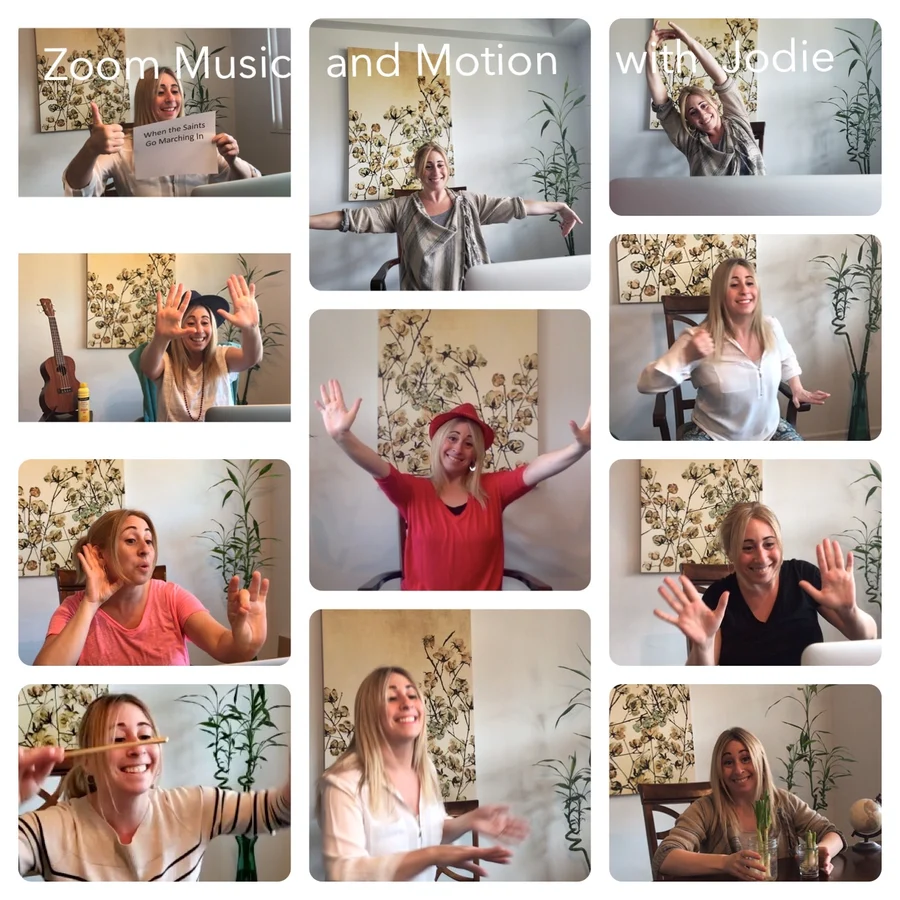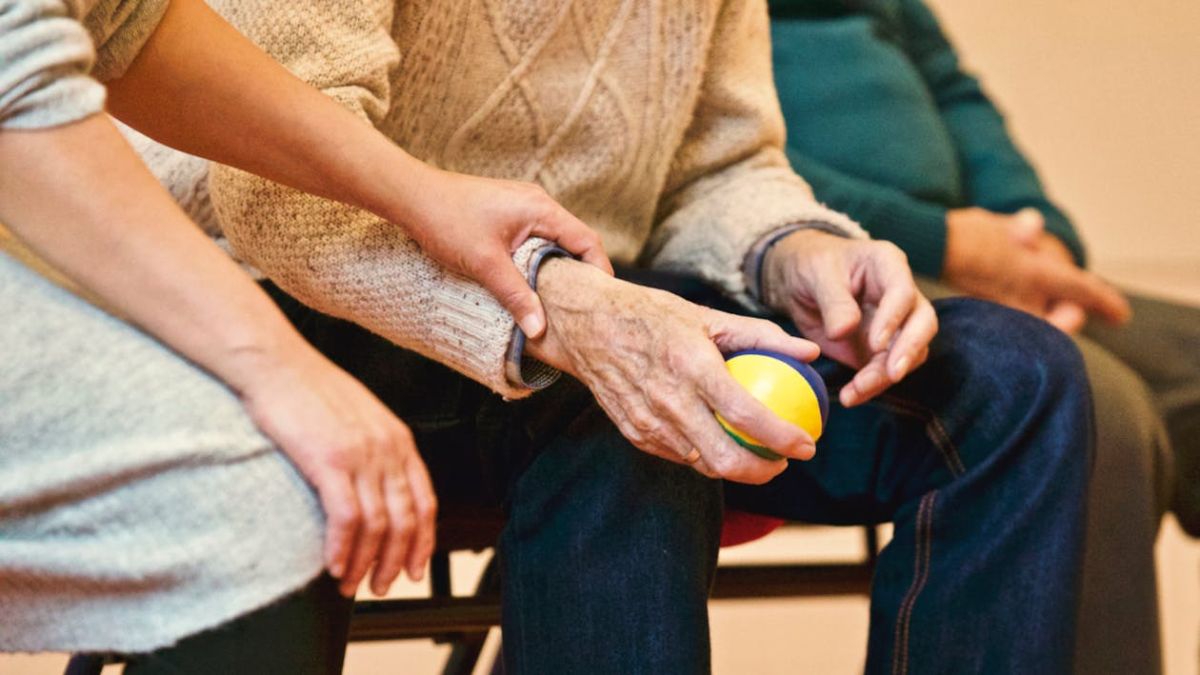by Jodie Berman, MS, CTRS and Grace Townley-Lott, LMSW
Studies show that social engagement combats cognitive decline, while prolonged isolation and loneliness accelerate it. Unfortunately, COVID-19 has interrupted our usual social engagement routines. Those with dementia have been hit especially hard by this isolation.
Luckily, we live in a time where we can turn to virtual social engagement. Virtual programs can provide routine and support to those with dementia while giving their caregivers some respite. However, this pivot to virtual has its own challenges for participants and instructors alike.

Our Director of Programs and Engagement, Certified Recreation Therapist Jodie Berman, MS, CTRS, has transformed and re-envisioned engagement for our True Bridge Memory Care clients through this pandemic. She now leads group classes as well as one-on-one virtual programs. Years of programming experience has helped her transition to leading classes on Zoom, rather than in-person. She’s compiled several tips for both caregivers and the instructors to help create a successful virtual experience for persons with dementia.
We’ll be using Jodie’s virtual Music and Motion class as an example to highlight what she’s learned about engaging through virtual programming. Music and Motion is a program designed specifically for those with dementia and cognitive impairments. It uses a strengths-based, meaningful approach to engage clients in the creative and expressive arts, through the therapeutic use of music, dance, movement, improvisation, and visual arts. Her goal is to create an inclusive experience that increases positive emotions, self-expression, and creativity. Numerous studies have highlighted the psychosocial benefits of artistic engagement for individuals living with dementia, and it’s exciting to see the same positive results in our virtual classes as we did in person.
Below are some fundamental tips for successful online engagement, particularly for someone with dementia. We’ve compiled suggestions for the caregiver in the home as well as the instructor leading the class.
Helpful Tips for In-Home Caregivers
- Secure your Internet connection, Zoom Member ID, and password or link in advance. Caregivers can sign on for the client or with the client. Zoom sign-on training is essential. There is good tech support available for older adults; check out candootech.com/howto-offerings for a simple Zoom training.
- Point out the MUTE, VIDEO, GALLERY VIEW, and SPEAKER VIEW SETTINGS. Experiment with Zoom gallery view and speaker view to see which one you prefer for optimal participation and engagement.
- Turn off all environmental distractions like TV or radio. Open shades to allow sunlight with, and ensure good ventilation or air conditioning. A comfortable environment will help support the participant’s engagement by minimizing distractions.
- Use a chair with armrests instead of a couch. Create a space for classes to take place and use the same set-up for every virtual class.
- Ensure the participant has everything they need to participate at their fullest capacity, such as reading glasses and hearing aids.
- Work with the instructor to practice signing onto Zoom and prepare your settings.
- Caregivers are encouraged to pull up a chair and join the class.
Helpful Tips and Tricks for Instructors
| Rename each participant to the name they are willing to show to other participants. Jodie typically uses their preferred first name, as some clients choose not to showcase their last name.Use first names throughout the class to personalize their involvement and draw their attention. When a person hears their name, they are more likely to look at the screen and focus. | |
| Familiarise yourself with the latest Zoom audio/sound settings. Zoom no longer allows meeting hosts to unmute all participants at this time. If you have to mute a participant, please make sure the caregiver or the person knows how to unmute themselves, especially when you would like them to share verbal feedback. | |
| Introduce everyone by name. State the date and day of the week. You can incorporate this into your warm-up, which should be about 5 minutes. Start with a warm-up where all can contribute to. Keep a consistent routine, like a warm up song, or invite participants to create warm-up movements to share with the group. Encourage other participants to mirror or repeat. | |
| A themed class fosters greater engagement from participants. The participants can contribute themes in preparation for the next class.Use a different device for your music so you won’t need to toggle between multiple programs on your computer while leading the class. Have your music playlist ready in advance and place the device next to your computer for better sound. Keep “reality orientation” and person-centered themes in mind. Incorporate current holidays, themed music, travel, or personalized classes that focus on reminiscence to increase the level of participation. Use movement-based fitness, exercise, and dance-inspired routines. This includes chair-based fitness, Zumba, Tai Chi, yoga, meditation, cardio, strength and balance training, or low-impact workouts.Invite the group to count out loud with you during repetitions of movements. | |
| Encourage verbal and non-verbal participation. A simple thumbs-up or thumbs-down can be an effective communication strategy. Mirroring others’ movements, expressions, and words can foster greater social connection and interaction among participants. Example: “Show me a string instrument. Everyone, take a look at Nancy and mirror her movement playing the violin.” Example: “Show me a thumbs up or thumbs down if you agree or disagree,” or “Show me a thumb sideways if you are not sure.”You can utilize everyday tangible objects in your class when performing low-impact exercises or improvisation games. Example: A full water bottle is about 1.5 pounds — it also encourages hydration.Example: Two chopsticks or two pens can be used in creative ways and are readily accessible in the home. | |
| Use the “Share Screen” and “Spotlight” features for your classes. Doing this enables you to include other forms of engagement to enhance the class and support any sensory deficits. Some examples include:Sharing your screen to showcase a YouTube video, for Karaoke lyrics, travel clips, or dance/music videos to watch, listen, move to, and then discuss afterward. Jodie has found the most success with videos that are under 3 minutes. Sharing your screen to show a piece of artwork and generate discussion about the artUtilizing the “Spotlight” feature when a participant shares or tells a story places a participant at the center of focus on all participants’ screens. |

Instructor Tips for Concluding a Zoom Class
- Take time for a closure, debrief, or cool down at the end of the class.
- Encourage and promote questions, comments, and reactions from your class. Give at least 30 seconds for each participant to respond through verbal or non-verbal feedback.
- Example: Jodie typically concludes her Zoom classes with gratitude offerings from participants. They share well-wishes, loving-kindness meditation, moments of joy, or any other contribution they would like to offer.
- A fun way to end a class can include hydration and encourage more fluid intake. You can have a “virtual cheers,” where each person holds up a glass, brings it to the screen, smiles, and says “cheers” in any language. After this, thank everyone for their time and effort in class.
- Always let participants know the next class’s date and time and encourage them or their caregivers to write this information on their calendar so they can look forward to their next class.
Listen to what Peter has to say about the class
Jodie’s work with our clients is inspiring to watch. We’ve included some clips so you can experience the joy her classes bring. Participants get to see familiar faces week after week and build social connections that bring hope and cheer during this challenging time. These classes help create a routine, provide purposeful engagement, and foster positive feelings that linger long after the class is over. Until we can meet again in person, we’ll look forward to our next virtual “Cheers!”
https://play.hubspotvideo.com/v/3938498/id/35507696289?renderContext=onload-placeholder&parentOrigin=https%3A%2F%2Fwww.truecareny.com&pageId=35452632532&locale=en-us#hsvid=2fb982e8-ae32-47f4-bc7b-76dfc721129d&t=1692177408426&afterPreload=true





